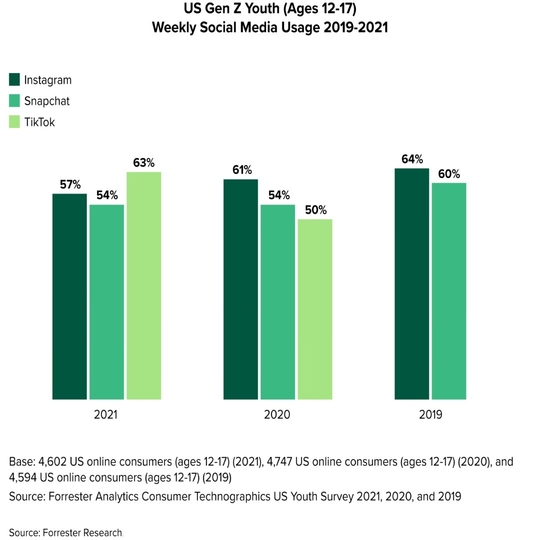
The State Of Data-Driven Marketing In 2023
In this article, we will take a look at the state of data-driven marketing in 2023 and how it is transforming the marketing landscape.
Read MoreAt [B]RIGHT, we illuminate data-informed digital solutions to help your brand succeed in an increasingly complex marketing landscape. Which means we help brands grow based on data, research, and a hefty dose of proven processes, tactics, and channel-specific strategies.
We take the guesswork out of your marketing strategy.
The Stories You Have to Read:

A Nielsen study of consumers aged 15 to 25 is disproving some common misconceptions about Gen Z habits. Some of the stereotypes being challenged are that Gen Z is made up of tech-addicted, frivolous spenders that are only reachable online, and that their time spent online is wasted.The study found that many Gen Z respondents spend 8+ hours per day outdoors and actually have a 73% ad recall of outdoor advertising, i.e., billboards and other signage. They are also reported to have a tendency toward adventure, sports, activities, and event-based trips, according to 66% of responses. Regarding the idea that Gen Zers are frivolous spenders, 76% stated they would postpone a purchase until it goes on sale, and 62% feel that financial independence is their top goal in life.
Everyone spends time online, and Gen Z is no different. But how are they spending their time? Ninety-two percent of Gen Z responses stated that their time online is for either their job or their studies. Their leisure time online is spent accessing news on current affairs (67% of respondents) and 50% of respondents said they research products and services they plan to purchase in the future. Lastly, the study found that 45% of the time is spent accessing their banking, trades, or investment information online.
High-tech flat-screen TVs continue to be surprisingly affordable considering their capabilities when compared to the latest smartphones and laptops. Television prices continue to stay low because manufacturers like Vizio are making their money selling user data, and the sale of the hardware is the means to make that happen.
Vizio is becoming an advertising firm, and in their third-quarter earnings report the company profited $57.3 million from the business segment platform that includes their advertising and viewer data. That figure is more than double its $25.6 million in profits from device sales. These changes in profit generators are not unique to Vizio; there are similar shifts taking place for other smart TVs and devices like Roku and Amazon Fire Stick. Roku’s platform brought in $532 million in the second quarter this year, which includes advertising. Smart TVs are expected to be in 90% of North American households by 2024, according to Strategy Analytics, and they represent an ever-growing advertising offering for marketers to utilize.
Twitter is a little late to offer livestream shopping as an e-commerce option, but nonetheless has now rolled out its initial test this month. Their livestream shopping UI houses the live feed at the top of the screen, and users can toggle the bottom of the screen between the live tweet discussion or the Shop tab that features all the products highlighted in the livestream broadcast. This new feature is one of a few other e-commerce initiatives that Twitter has rolled out in 2021. In July of this year, the platform also introduced shop modules that appear at the top of business profiles to facilitate online shopping.
Apple has announced that users will now have the option to designate up to five legacy contacts as beneficiaries of a user’s iCloud data after their death. Google and Facebook already have systems set up for families to access their deceased loved ones’ data, and Apple is just now catching up because of their long-standing position on protecting user privacy. The Digital Legacy program provides access to all personal information stored in the cloud, photos, documents, and even purchase history. Apple still requires proof of death and an access key to view their data, but the process is more streamlined now. iPhone users can activate Digital Legacy contacts by navigating to Settings > Password & Security and then to Legacy Contact. From there, just follow a couple prompts to complete setup.
A study by Forrester, a research and consulting firm, measured the weekly social media usage trends among Gen Z users, and the tendency toward TikTok certainly does not go unnoticed. The Chinese-owned platform TikTok has seen a 13 point year-over-year increase in weekly usage—up to 63% among US Gen Z users—while Instagram, owned by Meta (previously known as Facebook), saw a 4 point decrease in weekly usage.
Forrester’s study explores some of the reasons Gen Z users prefer TikTok through a series of focus groups interpreted by Gen Z parental figures. Overall, TikTok preference was rooted in the sentiment that users found TikTok content “fun” and “funny,” and their overall experience on TikTok was much more positive in comparison to Instagram. Other noteworthy sentiments include that the short-form variety keeps users engaged and they feel they can express themselves more freely on the platform.

The Verge, a popular online tech news publisher, has updated their public ethics policy to be clearer on their reporting, particularly in response to news about Big Tech companies. The Verge states that Big Tech companies and their communications staff have regularly navigated outside of what is considered acceptable sourcing practices and have deflected accountability by passing the burden of truth to the media while maintaining control of the narrative.
One strategy being used by big companies to shutter accountability is by answering questions “on background,” where the reporter is not to attribute information directly to a person by name or is requested to paraphrase commentary so that information is often obscured and vague. The Verge reports that this trend is becoming the norm with big companies and feeds into the distrust of media and the current landscape of news and information. In their article, they list out many examples of reporting where background has been leveraged in an attempt to control the narrative in the company’s favor.
The Verge has put it on blast that they intend to combat the overuse of “on background” requests, their new stance outlined below:
Facebook’s latest study into emerging shopping behaviors has uncovered several changes that commerce businesses should consider for the coming year. Eighty-one percent of US shoppers made a purchase in-store after discovering the item on social media, and this is why it is more important than ever to help fuel product discovery online and combine that with in-store availability and convenience. Seventy-two percent of US shoppers surveyed say they would be encouraged to revisit a store that uses QR codes for product availability information. Shoppers want to strike a balance between evaluating products in person, accessing online resources, and using augmented reality tools to see the product in their homes (especially in the case of home decor). VR solutions could enrich consumers’ in-store experiences, and 73% of shoppers surveyed stated that they would revisit a store if they could use augmented reality tech to experience available products.
Thanks for reading this month's marketing and tech-related news. We found these articles insightful and helpful in navigating the changing marketing landscape and hope they are of value to you too.
Until next time.
Seth Slone | Digital PM

In this article, we will take a look at the state of data-driven marketing in 2023 and how it is transforming the marketing landscape.
Read More
Marketers need to be agile and proactive in their planning, adapting to the changing landscape and staying ahead of the competition.
Read More
The marketing landscape in 2022 saw the continuation of several key trends, including the growing importance of data-driven marketing, the rise of e-commerce and the increasing dominance of digital channels.
Read More